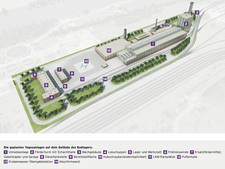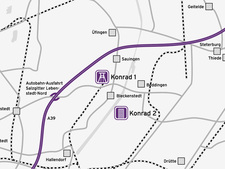-
Topics
subnavigation
Facilities at the surface
The surface installations of the Konrad mine in Salzgitter-Bleckenstedt were built prior to shaft sinking or immediately thereafter in the 1950s and 1960s. Since 2007, comprehensive building measures have been carried out for the construction of the repository.
The twin mine Konrad has two shafts, Konrad 1 and Konrad 2 that are located within 1.5 kilometres from each other. Their surface installations are situated inside the city boundaries of Salzgitter and cover an area of 11 or, respectively, 5.5 hectares. The Konrad 2 surface installations border on the western area of the Salzgitter AG premises.
Shaft Konrad 1
Shaft Konrad 1 has been used for the transportation of personnel, material and, later on, for the hoisting of debris to the surface. The winding gear is equipped with two three-storey cages and has a hauling capacity of 18 tonnes at a winding speed of ten metres per second. Konrad Shaft 1 is also the downcast ventilation shaft. In shaft 1, components of the future shaft hoisting system are currently being built in. This requires remediation work at the shaft brickwork.
Surface installations Konrad 1
On the premises of the Konrad 1 surface installations, some old buildings were dismantled and the southern winding machine building and the underground media channel was constructed. Construction of further buildings and the fencing of the facility started in spring 2013.
In the near future, staff buildings, storage facilities and workshops will be rebuilt and the existing shaft hall will be expanded. The hoisting plant will also be fully replaced in the future.
Shaft Konrad 2
Shaft Konrad 2 is the upcast ventilation shaft and will mainly serve to hoist the waste packages underground. Due to wear, the hoisting plant had to be taken out of operation. Therefore, the old hoisting frame and the shaft hoisting installations have already been dismantled.
In order to maintain the underground operation of the mine nevertheless, a temporary hoisting plant including hoisting frame is currently being operated. In the process of constructing the repository it is planned to build a hoisting plant with a high-performance eight-cable lift.
Surface installations Konrad 2

![]() Surface facilities at Konrad Shaft 2
Surface facilities at Konrad Shaft 2
The original surface installations at Konrad 2 were dismantled. To prepare the further building measures, an explosive ordnance clearance was carried out, as the premises were targets for the Allied Forces during World War II.
The new fencing has nearly been completed. Works for the future rail connection have already been carried out. Preparations are being made for the new road connection, so that works can start in 2013. Later on, the reloading hall, the buffer hall, the head frame including shaft hall and the ventilation building including diffuser will be built.
State of 2017.03.30


